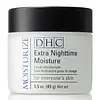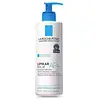What's inside
What's inside
 Key Ingredients
Key Ingredients

 Benefits
Benefits

 Concerns
Concerns

 Ingredients Side-by-side
Ingredients Side-by-side

Water
Skin ConditioningButylene Glycol
HumectantCetyl Ethylhexanoate
EmollientTriethylhexanoin
MaskingGlycerin
HumectantHydrogenated Palm Oil
EmollientOlea Europaea Fruit Oil
MaskingSqualane
EmollientGlyceryl Stearate Se
EmulsifyingStearic Acid
CleansingBehenyl Alcohol
EmollientPentylene Glycol
Skin ConditioningPolysorbate 60
EmulsifyingLeuconostoc/Radish Root Ferment Filtrate
AntimicrobialIsostearic Acid
CleansingPhenoxyethanol
PreservativeCarbomer
Emulsion StabilisingSerine
MaskingDipotassium Glycyrrhizate
HumectantPotassium Hydroxide
BufferingTocopherol
AntioxidantSodium Hyaluronate
HumectantIsostearoyl Hydrolyzed Collagen
CleansingWater, Butylene Glycol, Cetyl Ethylhexanoate, Triethylhexanoin, Glycerin, Hydrogenated Palm Oil, Olea Europaea Fruit Oil, Squalane, Glyceryl Stearate Se, Stearic Acid, Behenyl Alcohol, Pentylene Glycol, Polysorbate 60, Leuconostoc/Radish Root Ferment Filtrate, Isostearic Acid, Phenoxyethanol, Carbomer, Serine, Dipotassium Glycyrrhizate, Potassium Hydroxide, Tocopherol, Sodium Hyaluronate, Isostearoyl Hydrolyzed Collagen
Water
Skin ConditioningButyrospermum Parkii Butter
Skin ConditioningGlycerin
HumectantDimethicone
EmollientNiacinamide
SmoothingParaffinum Liquidum
EmollientCetearyl Alcohol
EmollientBrassica Napus Seed Oil
EmollientAmmonium Alum
AstringentAmmonium Polyacryloyldimethyl Taurate
Emulsion StabilisingPEG-100 Stearate
Glyceryl Stearate
EmollientPEG-20 Methyl Glucose Sesquistearate
EmulsifyingCera Microcristallina
Emulsion StabilisingParaffin
PerfumingSorbitan Tristearate
EmulsifyingDimethiconol
EmollientMannose
HumectantDisodium EDTA
Capryloyl Glycine
CleansingVitreoscilla Ferment
Skin ConditioningXanthan Gum
EmulsifyingPentaerythrityl Tetra-Di-T-Butyl Hydroxyhydrocinnamate
AntioxidantSodium Benzoate
MaskingWater, Butyrospermum Parkii Butter, Glycerin, Dimethicone, Niacinamide, Paraffinum Liquidum, Cetearyl Alcohol, Brassica Napus Seed Oil, Ammonium Alum, Ammonium Polyacryloyldimethyl Taurate, PEG-100 Stearate, Glyceryl Stearate, PEG-20 Methyl Glucose Sesquistearate, Cera Microcristallina, Paraffin, Sorbitan Tristearate, Dimethiconol, Mannose, Disodium EDTA, Capryloyl Glycine, Vitreoscilla Ferment, Xanthan Gum, Pentaerythrityl Tetra-Di-T-Butyl Hydroxyhydrocinnamate, Sodium Benzoate
Ingredients Explained
These ingredients are found in both products.
Ingredients higher up in an ingredient list are typically present in a larger amount.
Glycerin is already naturally found in your skin. It helps moisturize and protect your skin.
A study from 2016 found glycerin to be more effective as a humectant than AHAs and hyaluronic acid.
As a humectant, it helps the skin stay hydrated by pulling moisture to your skin. The low molecular weight of glycerin allows it to pull moisture into the deeper layers of your skin.
Hydrated skin improves your skin barrier; Your skin barrier helps protect against irritants and bacteria.
Glycerin has also been found to have antimicrobial and antiviral properties. Due to these properties, glycerin is often used in wound and burn treatments.
In cosmetics, glycerin is usually derived from plants such as soybean or palm. However, it can also be sourced from animals, such as tallow or animal fat.
This ingredient is organic, colorless, odorless, and non-toxic.
Glycerin is the name for this ingredient in American English. British English uses Glycerol/Glycerine.
Learn more about GlycerinWater. It's the most common cosmetic ingredient of all. You'll usually see it at the top of ingredient lists, meaning that it makes up the largest part of the product.
So why is it so popular? Water most often acts as a solvent - this means that it helps dissolve other ingredients into the formulation.
You'll also recognize water as that liquid we all need to stay alive. If you see this, drink a glass of water. Stay hydrated!
Learn more about Water